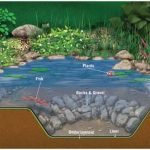To seal a pond, you can use a combination of pond liners, clay, or bentonite. Firstly, evaluate the condition of the pond and remove any debris or vegetation.
Begin by applying a layer of clay or bentonite to the pond’s bottom and sides. Alternatively, install a pond liner that extends to the edges and overlaps at the seams. Ensure that the liner is securely anchored to prevent leaks.
Test the effectiveness of the seal by filling the pond with water and monitoring for any seepage.

Credit: sanitred.com
Understanding Pond Sealing
Understanding Pond Sealing is crucial for maintaining the integrity of your pond and preventing leakages that can lead to water loss and environmental damage.
Importance Of Pond Sealing
Properly sealing your pond is essential to prevent water seepage and maintain water levels for aquatic life and landscaping.
Common Reasons For Pond Leakage
- Inadequate pond lining
- Tree roots puncturing the pond lining
- Settling of the pond bed
- Cracks in the pond structure
Assessment And Preparation
Assessment and Preparation are crucial steps in sealing a pond. Before starting the process, inspect the pond area and gather the necessary tools and materials.
Inspecting The Pond Area
Look for leaks, cracks, and potential water loss points by visually examining the pond. Identify any debris that may hinder the sealing process.
Gathering The Necessary Tools And Materials
- Plastic liner
- Pond sealant
- Utility knife
- Roller or brush
- Measuring tape
- Sealant applicator
Choosing The Right Sealing Method
If you want to ensure your pond remains leak-free and functional, choosing the right sealing method is crucial. By selecting the appropriate sealing technique, you can prevent water loss and maintain the overall health of your pond. In this article, we’ll explore the various options available for sealing ponds, and the factors you should consider when making this important decision.
Considering Different Pond Sealing Options
When it comes to sealing a pond, there are several options you can consider to effectively prevent water seepage. Each method offers its own benefits and drawbacks, so it’s important to research and understand each option before making a decision.
Factors To Consider When Selecting A Sealing Method
Before choosing a sealing method for your pond, there are several key factors to take into account. These include the size and depth of your pond, the type of soil or substrate at the pond bottom, the presence of any underwater springs or streams, and your overall budget for the project. Considering these factors will help you make an informed decision that suits the specific needs of your pond.
Credit: www.fao.org
Application Process
Sealing your pond is essential to prevent leaks and maintain optimal water levels. To ensure a successful application process, follow these steps:
Preparing The Pond Surface
- Before applying the chosen pond sealer, remove any debris or vegetation from the pond surface. This will ensure proper adhesion.
- Thoroughly clean the pond surface using a high-pressure washer or a stiff brush. This step is crucial to remove any dirt, algae, or old sealant that may interfere with the new application.
- Repair any cracks or damages using a suitable sealant, ensuring that the surface is smooth and level. This will create a solid foundation for the new sealant.
Step-by-step Application Of The Chosen Pond Sealer
- Read the manufacturer’s instructions carefully to understand the specific requirements of your chosen pond sealer. Different sealers may have different application methods and curing times.
- Pour the pond sealer into a clean and dry container, ensuring that it is well-mixed to achieve a consistent texture.
- Using a paintbrush or roller, apply a thin and even layer of the sealer onto the pond surface. Ensure that all areas are covered, including the edges and corners.
- Allow the first layer to dry according to the manufacturer’s instructions, usually for a minimum of 24 hours.
- Apply subsequent layers of the sealer, following the same technique as before. Multiple layers may be necessary to achieve the desired thickness and durability.
- After the final layer has been applied, allow the sealant to cure completely. This may take several days, depending on the product and weather conditions.
Following these steps during the application process will help ensure a proper seal for your pond, preventing leaks and maintaining its functionality for years to come.
Ensuring Long-lasting Protection
Learn how to seal your pond effectively for long-lasting protection. Follow these easy steps to ensure your pond stays leak-free and maintains its beauty for years to come.
Ensuring Long-Lasting Protection Sealing your pond is a vital step in protecting it from leaks and maintaining its water levels. To ensure long-lasting protection, proper post-sealing maintenance and care, as well as regular monitoring, are essential.Post-sealing Maintenance And Care
1. Regular Inspection: After sealing your pond, conduct regular inspections for any signs of damage, wear, or potential leaks. This will help in identifying and addressing any issues promptly. 2. Vegetation Control: Manage the vegetation in and around the pond to prevent roots from penetrating the pond liner and causing damage. Regularly trim and remove any invasive plants. 3. Water Quality Management: Monitor the water quality of your pond and take necessary measures to maintain healthy conditions for aquatic life. This includes testing the pH levels, oxygen content, and addressing any imbalances. 4. Repairing Damage: Address any punctures, tears, or damage to the pond liner immediately to prevent further deterioration. Quick repairs will prolong the life of the sealant.Tips For Monitoring The Sealed Pond
1. Water Level Checks: Regularly monitor the water level in your pond to ensure there are no unexplained changes. Sudden drops in water level may indicate a leak that needs immediate attention. 2. Wildlife Observation: Keep an eye on the wildlife and plant life in and around your pond. Unusual behavior or decline in wildlife may hint at underlying issues with the pond environment. 3. Weather Impact: Be mindful of extreme weather conditions and their potential impact on your pond. Heavy rainfall and freezing temperatures can strain the pond sealant, leading to possible damage. 4. Record Keeping: Maintain a log of your pond maintenance activities, inspections, and any changes observed. This will help track trends and identify potential issues early on. By implementing these post-sealing maintenance practices and closely monitoring your sealed pond, you can ensure its long-lasting protection and enjoy a healthy and sustainable aquatic ecosystem.Environmental And Safety Considerations
Before embarking on the process of sealing a pond, it is crucial to take into account the environmental and safety considerations. Sealing a pond may have both positive and negative impacts on the ecosystem and it is important to ensure that safety measures are followed throughout the process. Let’s take a closer look at these factors:
Impact Of Sealing On The Ecosystem:
Sealing a pond can disrupt the natural balance of the ecosystem, affecting various plants and animals that rely on the pond for their survival. It is important to consider how this process can impact the biodiversity and overall health of the aquatic habitat.
While sealing a pond can prevent water leakage and contribute to water conservation, it can also reduce the availability of vital resources for aquatic organisms. For example, sealing can restrict the flow of oxygen and nutrients, leading to a decrease in dissolved oxygen levels and affecting the survival of fish and other aquatic organisms.
Additionally, sealing a pond may also alter the temperature of the water, which can further impact the aquatic life. It is important to carefully evaluate the overall impact of sealing a pond on the ecosystem and make informed decisions to minimize any negative consequences.
Safety Measures During The Sealing Process:
Ensuring safety during the sealing process is of utmost importance to prevent accidents and potential harm to humans and the environment. Here are some essential safety measures to consider:
- Proper Protective Gear: Wear appropriate personal protective equipment (PPE) such as gloves, goggles, and respirators to protect yourself from harmful chemicals and materials used during the sealing process.
- Safe Handling of Materials: Handle sealing materials carefully and follow the manufacturer’s instructions to avoid any spills or leaks that could contaminate the water or soil.
- Preventing Runoff: Take precautions to prevent any runoff of sealing materials into nearby water bodies, as they can have harmful effects on aquatic life. Use barriers or containment measures to limit the spread of sealing materials.
- Proper Waste Disposal: Dispose of any unused sealing materials and waste in accordance with local regulations and guidelines. Avoid dumping them in water bodies or on land.
- Ensure Adequate Ventilation: if working in confined spaces, ensure proper ventilation to prevent the buildup of harmful gases or vapors.
By adhering to these safety measures, you can minimize risks and contribute to a safe working environment during the sealing process.
Cost-effective Solutions
Exploring cost-effective solutions for pond sealing can help you maintain a beautiful pond without breaking the bank.
Evaluating The Cost Of Pond Sealing
Before you start the pond sealing process, assess the overall cost involved to ensure proper planning.
Budget-friendly Tips For Pond Sealing
- Consider using DIY pond sealant kits for affordable solutions.
- Opt for natural clay or bentonite to save on material expenses.
- Consult with professionals for guidance on cost-effective sealing techniques.

Credit: m.youtube.com
Professional Help Vs. Diy
When it comes to sealing a pond, you have two main options: seeking professional help or doing it yourself. Let’s explore the pros and cons of each approach so you can make an informed decision.
Pros And Cons Of Hiring Professionals
- Pros: Expertise in pond sealing.
- Cons: Higher cost compared to DIY.
Benefits And Challenges Of Diy Pond Sealing
- Benefits: Cost-effective solution.
- Challenges: Requires time and effort.
Conclusion
In closing, sealing your pond is a vital step in maintaining its health and longevity. Choose the right sealant, prepare the pond properly, and apply the sealant correctly for optimal results. By taking these steps, you can ensure that your pond remains free from leaks and maintains a healthy environment for aquatic life.





